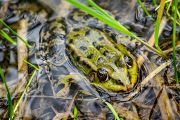
Unique reproductive strategy confirmed in another frog species in Moravia
28. 03. 2024
Only male edible frogs live in the Poodří region, with no females present. Even so, these frogs still reproduce with the help of partners from another frog species. This remarkable reproductive strategy that avoids mixing genetic information from both parents has now been confirmed by scientists from the Institute of Animal Physiology and Genetics of the CAS in another species of frog found in France and Spain. The researchers described the phenomenon in the journal Genome Biology and Evolution.
The edible frog (Pelophylax esculentus) is a hybrid species that evolved from the hybridisation of the pool frog (Pelophylax lessonae) and the marsh frog (Pelophylax ridibundus). “Edible frogs are something like half-clones. They always carry one set of chromosomes of the parental species and need to acquire the second set during mating,” Lukáš Choleva from the Institute of Animal Physiology and Genetics of the Czech Academy of Sciences (CAS) explained for the CAS magazine, A / Věda a výzkum.
Around the end of April and beginning of May, when frog courtship typically begins and croaking resounds all over the banks of ponds and pools, male edible frogs attract the females of marsh frogs. Such mating results in small male edible frogs and female marsh frogs. The scientific term for this type of reproduction is hybridogenesis.
French frogs have it similar
A very similar type of reproduction has now been confirmed by researchers from Lukáš Choleva’s team in their study of populations of Graf’s hybrid frog (Pelophylax grafi), which can be found in France and Spain. Like the edible frog, Graf’s hybrid frog is a hybrid species. It evolved via the crossing of the marsh frog (Pelophylax ridibundus) and the Iberian water frog (Pelophylax perezi).
Scientists examined details about the reproduction of Graf’s hybrid frog on the basis of genome research, in which they labelled and colour-differentiated the chromosomes of both presumed parental species. “The results of whole-genomic in situ hybridisation on the chromosomes of Graf’s hybrid frog clearly differentiated the chromosome set of one parental species from the other,” Choleva explains. “The karyotype of this southern European frog looks as if we were looking at the first generation of hybridisation between both parental species. However, we know that it has been crossbreeding with its parental species in populations for at least hundreds or thousands of years,” the researcher adds.
If genetic information from the mother and father were exchanged normally as in the case of most other vertebrates, including humans, then individual chromosomes would put together a colourful mosaic of both parental species. “It is therefore clear that Graf’s hybrid frog is indeed another example of a European amphibian that reproduces via a form of clonal reproduction, during which it has the ability to pass on the genome of only one parent – either the father or the mother – but never both parents, as is the case with humans,” Choleva adds.

Graf’s hybrid frog, male. (Photo: Veronika Labajová)
Endangered species
The discovery suggests that clonal reproduction is likely a more widespread phenomenon than previously thought. And not only among frogs, but among other species with hybrid origins as well.
The research results will help better understand the biology and diversity of amphibians, which play an indispensable role in our planet’s ecosystems. According to Choleva, it is ironic that we are learning about the evolution of unique reproductive strategies from amphibians – one of the most endangered groups of animals in the world.
We recently shot a photo story during our field research on the edible frog. Check out the photos below.
Prepared by: Leona Matušková, External Relations Division, CAO of the CAS, drawing on the CAS press release
Translated by: Tereza Novická, External Relations Division, CAO of the CAS
Photo: Jana Plavec, External Relations Division, CAO of the CAS; Veronika Labajová, Institute of Animal Physiology and Genetics of the CAS
Read also
- An epileptic seizure doesn’t always strike out of the blue, says Jaroslav Hlinka
- Radomír Pánek nominated for the next President of the CAS
- Four CAS projects get ERC Consolidator Grants, each to receive two million euros
- Groundbreaking study maps brain’s recovery process after stroke
- A / Magazine: light, the dawn of quantum computing, and no man’s lands
- Of Mice and Men: Researchers reveal link between human and mouse migration paths
- Czech and Saxon Academies of Sciences to strengthen cooperation on key issues
- Laser micromachining: inspired by sharks
- CAS researchers received the 2024 Praemium Academiae and Lumina Quaeruntur
- Light – Illuminating the invisible
The Czech Academy of Sciences (the CAS)
The mission of the CAS
The primary mission of the CAS is to conduct research in a broad spectrum of natural, technical and social sciences as well as humanities. This research aims to advance progress of scientific knowledge at the international level, considering, however, the specific needs of the Czech society and the national culture.
President of the CAS
Prof. Eva Zažímalová has started her second term of office in May 2021. She is a respected scientist, and a Professor of Plant Anatomy and Physiology.
She is also a part of GCSA of the EU.

















